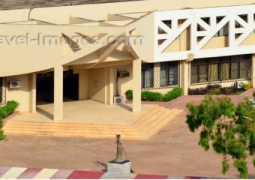Field guide to wildlife of the
By David Penney
554 colour photographs.
Published by Siri scientific press
POLITICIANS, priest, professors, journalist: they’re all the ‘green’ now – aware of the beauty of the created world around us and the importance of cherishing it, and telling the rest of us how we should take care of the environment.
How far this massage has got across to the people in general is not clear. Some schools in the
There’s much ‘missionary work to be done to enlist everyone’s interest and concern in their natural environment, and at the local level a book like David Penney’s is highly welcome.
Photographs galore
Dr penney is a retired zoologist living in the
His field guide to wildlife in the
Dr Penney remarks that the
He describes the sub-tropical climate as ‘pleasant’. November to June features dry savannah winds, whereas from July to October there are heavy downpours, much over-night, and the country becomes ‘lusciously green’. The diversity of plant and animal life is most spectacular during the rainy season.
Variety of habitats
The variety of the Gambia’s natural habitats includes marine and coastal, estuary and mangroves, brackish and freshwater river banks, swamp forest, freshwater swamps and other wetlands, forested areas for example, (at Abuko and Tanji) and woodland , savannah, farms are urban environments. so there’s a high biodiversity of indigenous plants and animals ‘but our knowledge of fauna and flora , ‘says Dr Penney, is far from complete’. Plants which are useful (for example, for building, for medical properties, as food, or are dangerous to people or crops) are the best known.
Dr Penney says that insects, spiders, scorpions, millipedes and centipedes are most poor-studied and so form the main focus of his guide. Many of the species he illustrates are ‘first records’ in this country, ‘and may even be new to science’. This then is substantially a book of pictures interspersed with short, clearly written material; ideal for those new to ‘nature watching’ as for those more experienced.
Diversity and beauty
On plants, Dr Penney says one cannot fail to be amazed at their diversity and beauty, particularly during the rainy season. Over 1,000 plant species – trees, shrubs, herbs and grasses- have been recorded. Many are slowly and difficult to miss, but others require a keen (and interested) eye.
Excluding domestic species, there are over 100 species of mammals - over thirty species of bats, alone. The majority of the other species are rodents, carnivores and ungulates (animals with horns). Many animals are nocturnal and secretive, including the tiny bush baby.
Lions giraffes and elephants lived in the
The
‘Don’t feed the monkeys!’
Here’s a warning to our visitors: ‘don’t feed the monkeys!’ in their natural environment monkeys have all food they need. Feeding them increase the risk of catching fatal diseases such as rabies and herpes B, and makes the monkeys aggressive towards humans. Giving them food increases the size of the monkey population beyond the capacity of the forest, and encourages them to leave their natural habitat. Many of don’t know what ‘insect’ means. There are said to be three million insects’ species in
Here’s a ‘taster’ of Dr Penney’s text, which is succinct and clear for those with only a slight knowledge of ‘nature’:
Termites (order Isoptera) live in large colonies and are highly social animals. Particularly large termite mounds may exceed four meters in height and exist for decades, possibly centuries in some species. Beware, these mounds often serve as a refuge for snakes, bats and other animals to escape the heat of the day, so never poke your hand in one!
Spiders are not ants. Dr Penney is an internationally recognised expert on spiders, and says, ‘almost nothing is known about the Gambian fauna. Indeed, many of the photographs here represent the first records of these spider families for the country.’
Not just for tourists
Altogether, then, this guide is a practical and stimulating, particularly for those who want to observe for themselves. It’s not just a book for tourist, but will arise the interest of many Gambians in the beauty and variety of local plants and animals. There’s a short warning at the end: ‘there are some serious conservation issues relating to this living museum of natural history.’ Dr Penney points out that the forestry and wildlife departments have limited resources and a great land area to protect throughout the country. ‘please help protect the magnificent natural heritage of The Gambian people and their visitors for many generations to come.’
Available at Timbooktoo Tel:4494345



